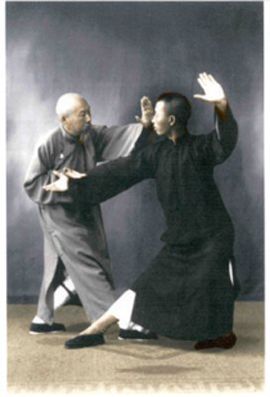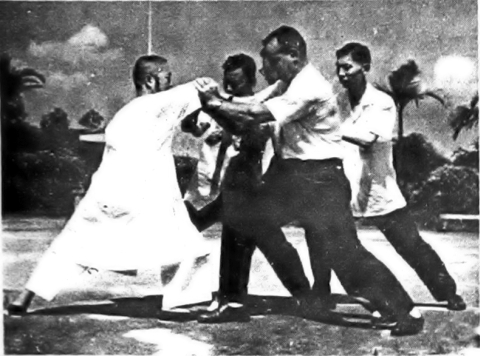PENG AND TAIJI QUAN’S 4 SKILLS
PENG AND TAIJI QUAN’S 4 SKILLS
Training in Taiji Quan my current perspective on the four skills of Zhang (to adhere) Lien (to sticking/yield), tie (to connect) and sui (to follow), arise from a good peng structure.
There is a previous post explaining Peng or the Peng structure of Taiji Quan here on deadlyduels.com. As your peng structure gets stronger, simultaneously so do the 4 skills.
SHARE THIS POST
What are the four skills?
Zhang (to adhere) this skill will refer to the expansion that occurs from building a peng structure, it holds fast to an opponent say in tuishou or the opponent if uprooted may appear to hold fast to you. Also, the English phrase, to adhere, means to take shape or follow in each situation. One of the qualities of a peng structure is the relaxation of joints and the lack of stiffness in the body. A stable structure, yet not a rigid one. There is a feeling of roundness and its not square.
Lien (to yield or stick), this would refer to quality from being able to adhere with the opponent you can stick to the opponent or if they are uprooted, they may appear to be stuck to you. On yielding this again, indicates not having stiff joints and the quality of the peng structure will enable you to able to redirect incoming force, from being able to yield and stick to the opponent.
Tie (to connect), building upon adhering, sticking, or yielding, you should connect with the opponent. Nonetheless, it starts with the self. When you sink and relax the mind and all the tension in the body, allowing this to dissipate into the ground. You are connecting with the ground and from this arises a peng structure. From the peng structure, you can connect with your opponent. And maintain this connection by maintaining your connection with the ground. From my current understanding, you no longer exist and becoming a sort conduit, connecting your opponent with the ground. You do this with the sinking, as this makes you empty of tension, empty of everything.
Sui (to follow), with the peng structure, you will then be able to follow or detect your opponent’s incoming force as follow refers to sensitivity. This will then allow you to redirect the force. For forces in physics are vectors, meaning a force has magnitude and direction. And with the peng structure as you “follow” you feel and redirect your opponent’s force.
SHARE THIS POST
View this post on Instagram Need to practice more, leaning too forward. I will post my mistakes as well don't care. “PENG AND TAIJI QUAN’S 4 SKILLS PENG AND TAIJI QUAN’S 4 SKILLS Training in Taiji Quan my current perspective on the four skills of Zhang (to adhere) Lien (to sticking/yield), tie (to connect) and sui (to follow), arise from a good peng structure.” read more on deadlyduels.com #chemanchingyngstyletaijiquan #deadlyduels #deadlyduelsmedia #podcast #spotifypodcast #combat #martialart #strategy #psychology #daoism #sport #selfdefence #chinesekungfu #motion #youtube #tactics #fighting #kickboxing #savate #daoism #daoistmonologue #daoistmonologueepisode13 #mindset #taichichuan #themind #wuwei #philosophy #taiji #artofwar #wushu
A post shared by DeadlyDuels Media (@deadlyduels) on
Need to practice more, leaning too forward. I will post my mistakes as well don't care. “PENG AND TAIJI QUAN’S 4 SKILLS PENG AND TAIJI QUAN’S 4 SKILLS Training in Taiji Quan my current perspective on the four skills of Zhang (to adhere) Lien (to sticking/yield), tie (to connect) and sui (to follow), arise from a good peng structure.” read more on deadlyduels.com #chemanchingyngstyletaijiquan #deadlyduels #deadlyduelsmedia #podcast #spotifypodcast #combat #martialart #strategy #psychology #daoism #sport #selfdefence #chinesekungfu #motion #youtube #tactics #fighting #kickboxing #savate #daoism #daoistmonologue #daoistmonologueepisode13 #mindset #taichichuan #themind #wuwei #philosophy #taiji #artofwar #wushu
A post shared by DeadlyDuels Media (@deadlyduels) on
These four skills are not to be separate, but qualities that arise with the peng structure and work simultaneously. That is my current understanding as I practice. These skills or the peng structure has the health benefit of enabling you to deal with stress better. Also, help you understand yourself better. The relaxation of the joints with the mind will allow better blood flow and with that more added health benefits. As for combat, it refines your fighting ability. This is not easy, and I am not even close to using this in fighting yet, only glimmers now and then. But I continue to practice.
Written by Narcisse Sadi, Tudi (student) of Dr Jeff Lan, certified (by the International Health Qigong Federation) 1stDuan Health Qi Gong and certified (by Dr Jeff Lan) 1st Duan Yang Style (Cheng Man Ching lineage) Tai Chi Chuan Instructor.
SUBSCRIBE AND STAY UPDATED
Get all our posts, blogs and video content via e-mail.
We promise. No spam.
Online Members
No online members at the moment



Comments
Leave a Comment